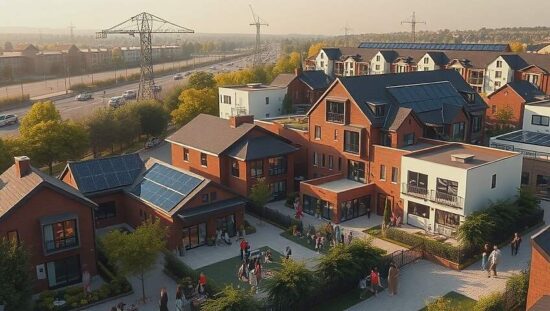In March 2025, Germany approved the construction of 19,500 new homes, according to the Federal Statistical Office (Destatis). This represents an increase of 5.8% or 1,100 approvals compared to March 2024.
The first quarter of 2025 saw a total of 55,400 housing units approved, a rise of 3.4% or 1,800 units compared to the same period in 2024. These figures encompass both new residential and non-residential buildings as well as new apartments in existing structures.
A total of 16,000 new homes were approved in newly built residential areas in March 2025, an increase of 8.9% or 1,300 units compared to the previous year’s figure. Over the first quarter of 2025, a total of 46,100 new homes were approved, a rise of 4.1% or 1,800 units compared to the same period in 2024. The number of approvals for single-family homes increased by 15.3% (+1,400) to 10,600. In contrast, the number of approvals for two-family homes decreased by 8.9% (-300) to 3,000 approved units. The number of approvals for the most common building type, multi-family homes, remained largely unchanged at 28,800 units compared to the same period in the previous year, according to the Federal Statistical Office.
Overall, these figures demonstrate a positive trend in the German housing market, with both monthly and quarterly approvals on the rise. However, there are some regional variations in the types of homes being constructed, with single-family homes and multi-family homes seeing different levels of growth. Despite these differences, the trend towards more sustainable and energy-efficient construction methods is expected to continue, as the government aims to reduce the country’s carbon footprint and improve the overall quality of life for its citizens. As the housing market continues to grow, it will be interesting to see how these trends evolve in the coming years and whether the government’s efforts to encourage sustainable construction will have a lasting impact on the industry. Despite the positive figures, there are still challenges facing the housing market, including the need to address the issue of affordability and to ensure that new homes are built in areas that are well-connected to public transport and other essential services. However, with the right policies and incentives in place, there is potential for the German housing market to continue to grow and thrive in the years ahead. Overall, the trend towards more sustainable and energy-efficient construction methods is expected to continue, as the government aims to reduce the country’s carbon footprint and improve the overall quality of life for its citizens. As the housing market continues to grow, it will be interesting to see how these trends evolve in the coming years and whether the government’s efforts to encourage sustainable construction will have a lasting impact on the industry. Despite the positive figures, there are still challenges facing the housing market, including the need to address the issue of affordability and to ensure that new homes are built in areas that are well-connected to public transport and other essential services. However, with the right policies and incentives in place, there is potential for the German housing market to continue to grow and thrive in the years ahead.





